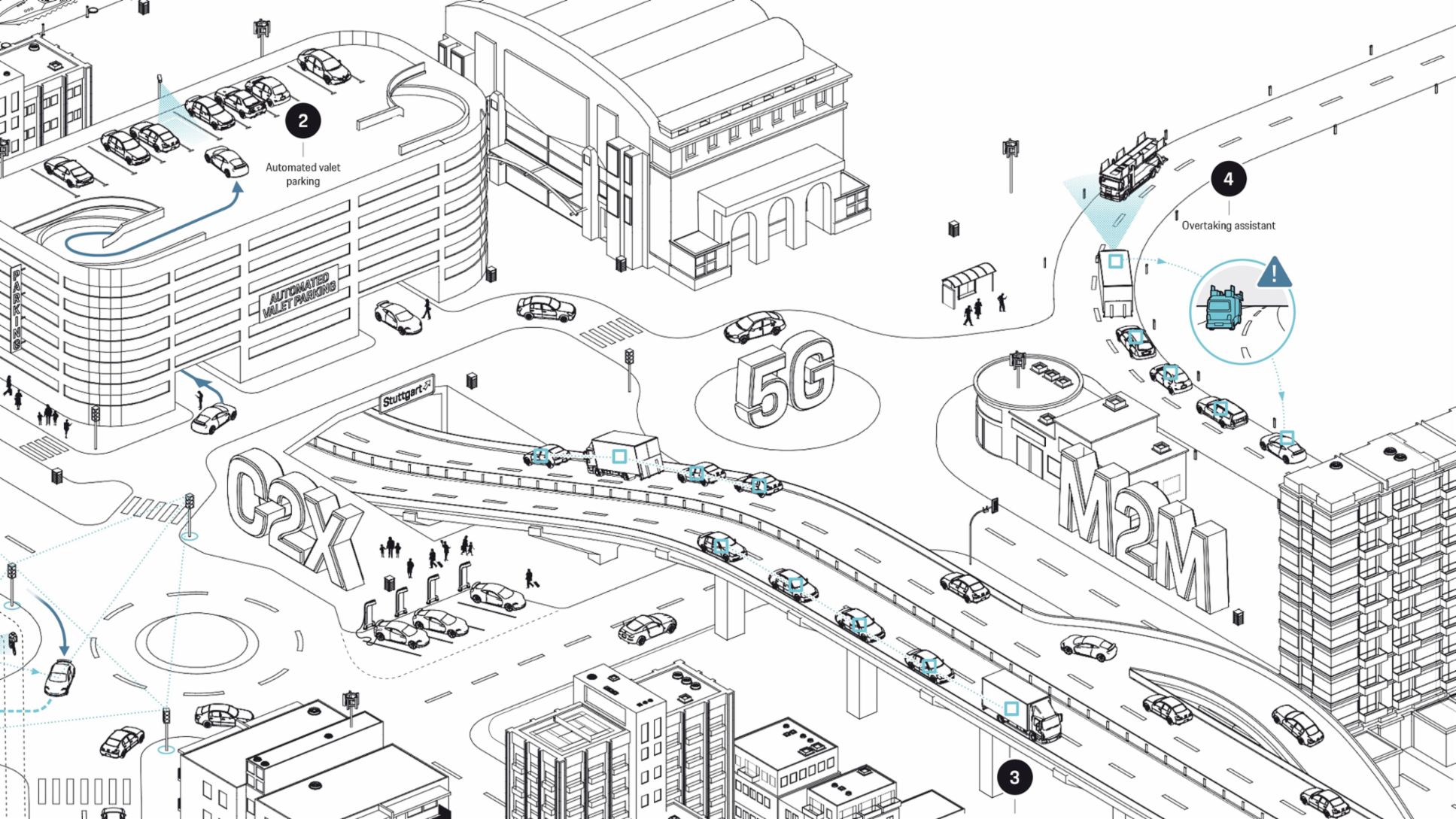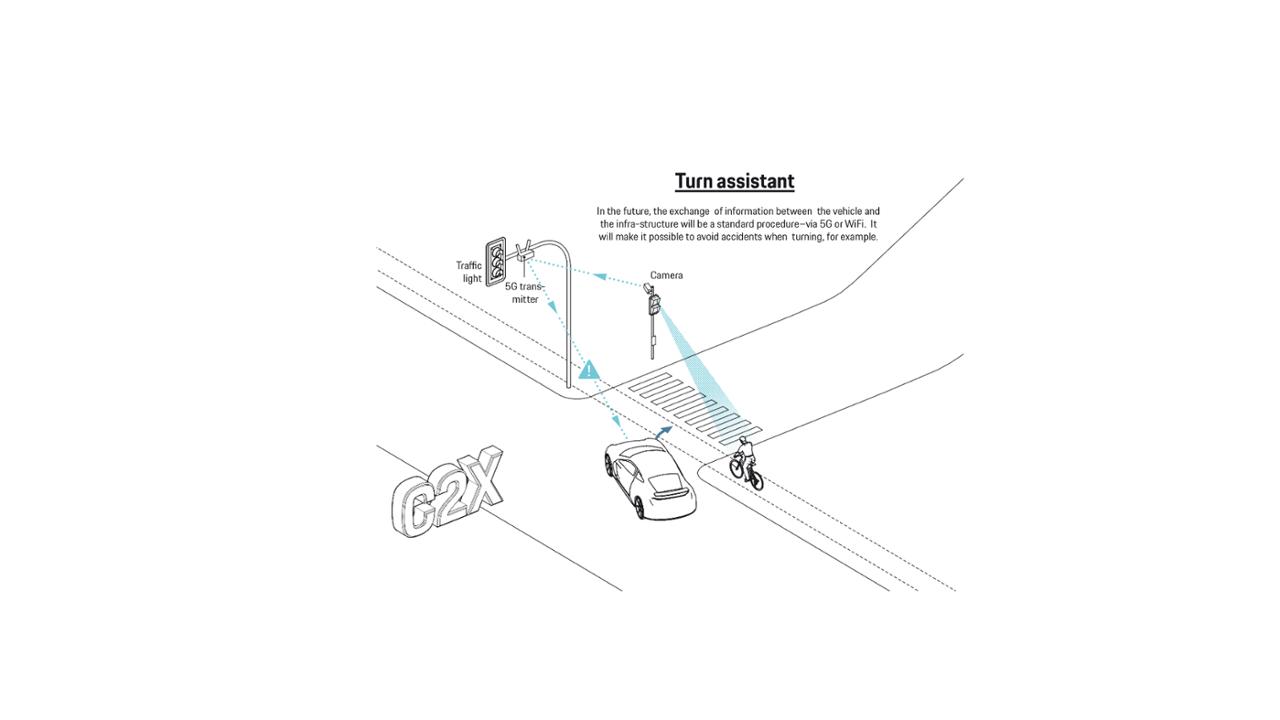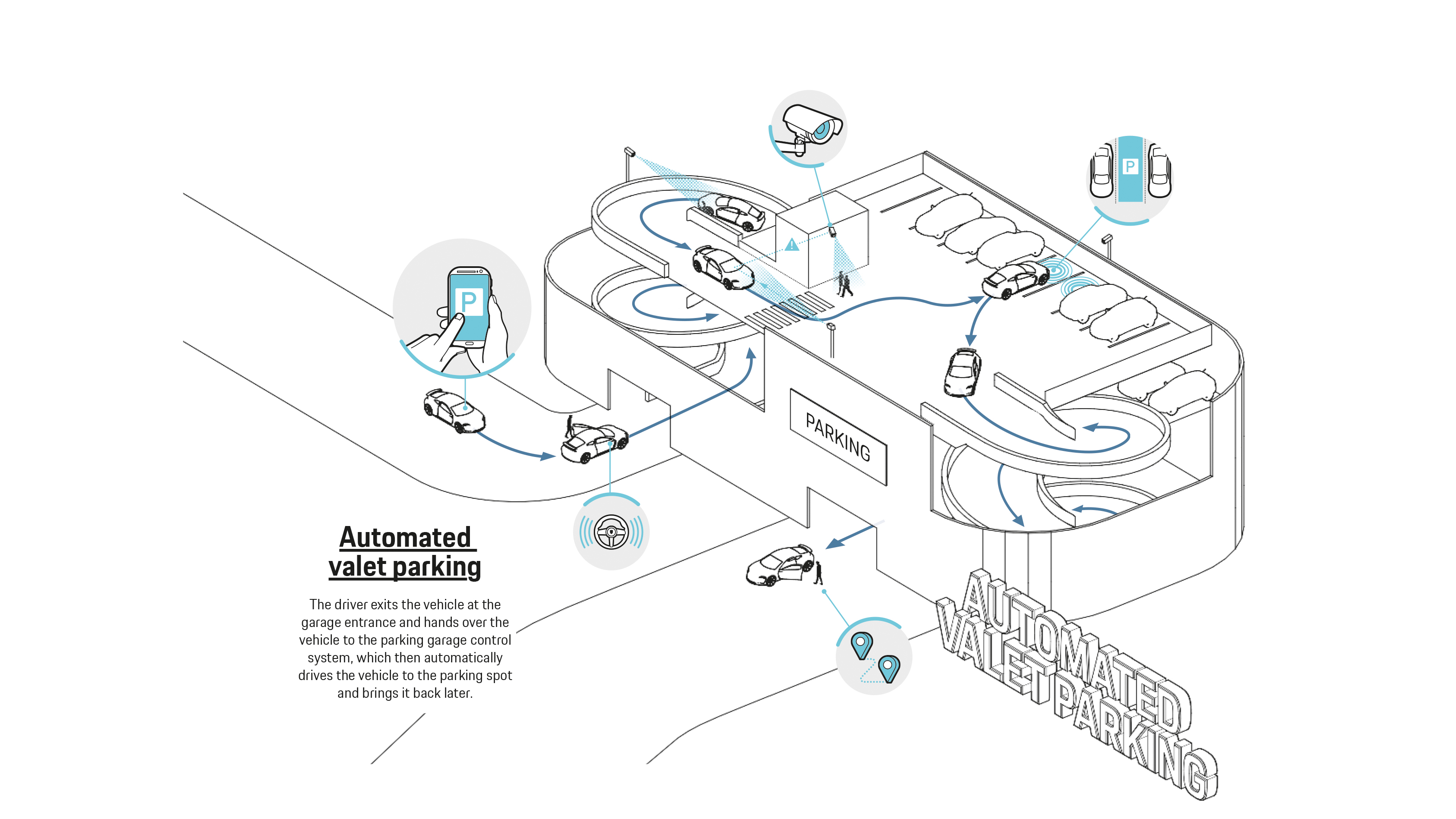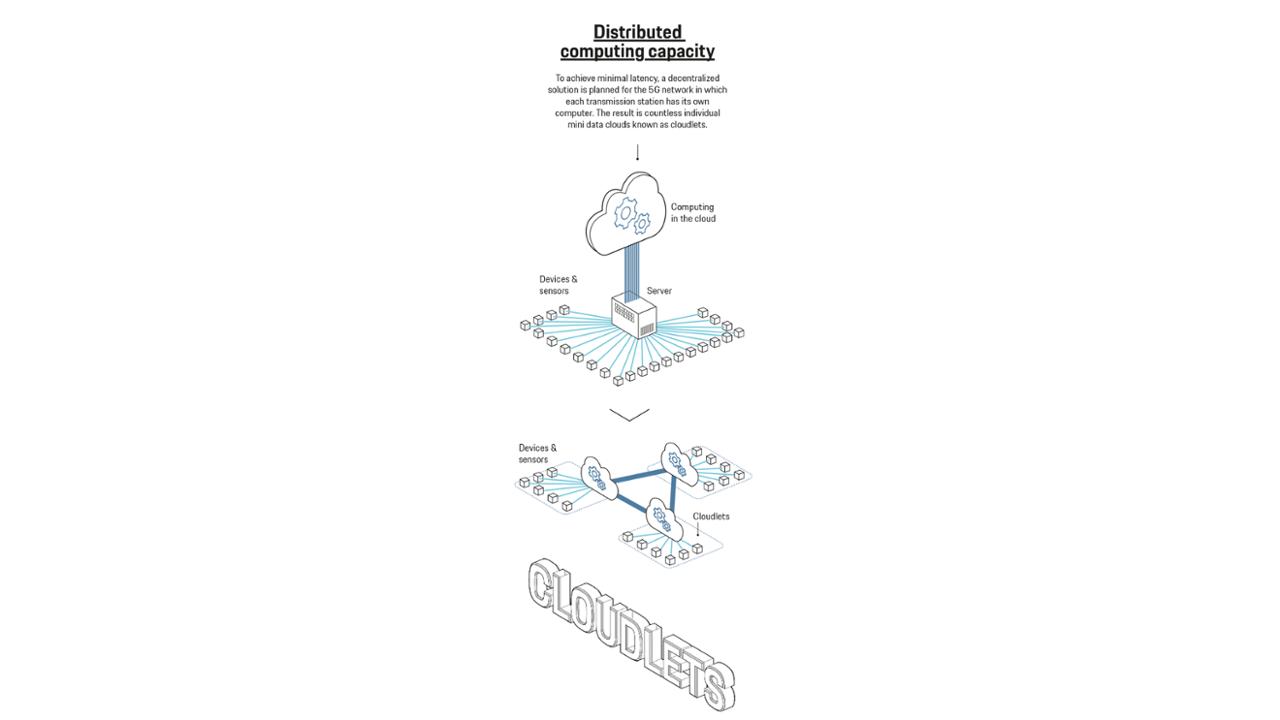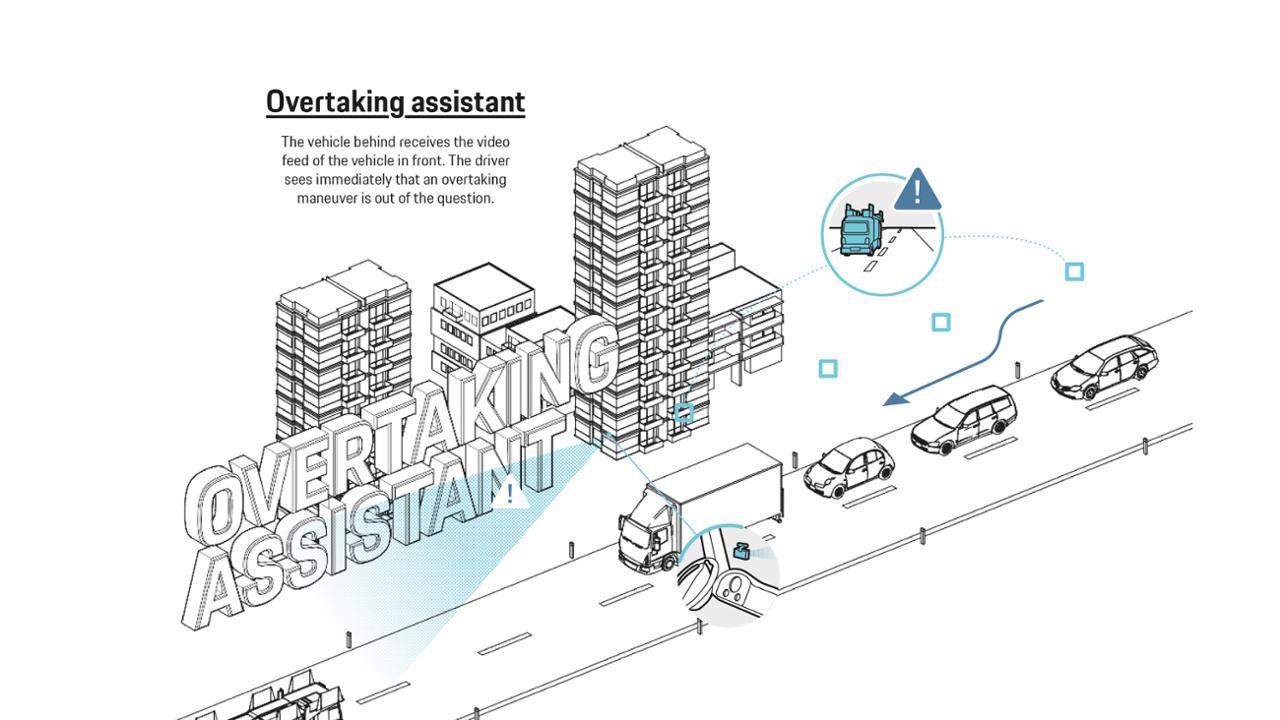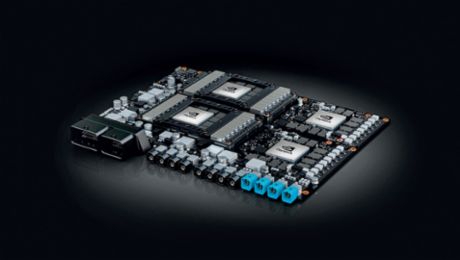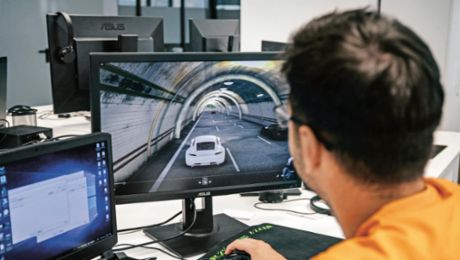The data volumes being transmitted via wireless networks are rising inexorably, due primarily to increasing machine-to-machine communication (M2M communication). In the automotive field, it is primarily fully automated driving that is spurring on this development: While the data volumes per hour in current highly networked vehicles are in the gigabyte range today, by 2025 the figure will be multiple terabytes.
5G networks play a decisive role in handling these large data volumes, because in contrast to 3G and 4G/LTE wireless networks, 5G was designed specifically for the characteristics and performance requirements of M2M communications. The network offers a much higher transmission rate of 20, rather than 1, Gbit/s. Moreover, latency—the time between a query and receipt of the response—was reduced from ten milliseconds to one. What that means is that data is transmitted almost in real time. For technical applications such as the remote control of robots or automated driving functions, that is a critical factor as high-performance, real-time connectivity in a networked system enables the implementation of new functions.
However, the theoretical time gains of the 5G network would be decimated in a conventional network topology with a centralized data center due to the excessively long transmission distances to the transmitter towers. To achieve minimal latency, therefore, the 5G network envisions a decentralized solution in which each transmission station has its own computer that receives, processes and independently retransmits data. There are countless individual mini data clouds known as cloudlets. This approach is also referred to as mobile edge computing, as the cloud and computer are at the edge, so to speak, of the mobile network. Furthermore, the machines in the 5G network can communicate directly with each other and without the detour via the transmission station. This can minimize transmission times even further.
Another advantage: Compared with 4G, 5G can also serve a larger number of end devices per network cell. The network prioritizes the applications and adjusts the transmission—if necessary—to the load situation. The data for time-critical applications is conducted through the network faster than other data, such as the video streams of private users.
Automated driving functions must naturally be designed in such a way that as many feasible eventualities that may arise during the drive can be recognized and handled entirely with the vehicle’s own assistance systems. That applies in equal measure on highways, rural roads, and urban roads. In borderline situations such as poor visibility or complicated traffic situations, additional information drawn from the exchange of data with the infrastructure or other vehicles—what is known as C2X communication—can substantially enhance the control accuracy of the onboard systems.
Taking the complete route into account
“Currently, the sensor technology on the vehicle only covers a range of a maximum of 300 meters around it. Using the sensor data from other vehicles and the infrastructure, information from all along the entire route can be taken into account,” explains Jaime Arveras, responsible for Connected Car functionality at Porsche Engineering. “Driving maneuvers can be much more effectively adapted to requirements and hazard situations detected at an early stage.” This, in turn, opens up entirely new possibilities for driver assistance systems. Turn assistance systems, for example, can, with the aid of a C2X connection, that the route is blocked by an accident.
In enclosed spaces such as parking garages, C2X communication enables automated valet parking. The driver exits the vehicle at the garage entrance and hands over the vehicle to the parking garage control system. It then drives the vehicle, completely automatically, to the parking space and later returns it in like fashion. Another example application based on C2X communication is currently being tested: coordinated driving of multiple vehicles in a line with minimal gaps between them. This “platooning” makes better use of the slipstream and could reduce fuel consumption, particularly in highway caravans of commercial vehicles driving in formation. Without fast communication, it is simply impossible: If one vehicle in the platoon brakes, the signal must be transmitted to the following vehicles without delay and braking immediately initiated there in order to avoid rear-end collisions.
“Both concepts have their specific advantages and disadvantages. In the medium term, there will probably emerge a hybrid system in which the paths are used redundantly.” Dominik Raudszus, team leader for networking and testing at the Institute for Automotive Engineering at RWTH Aachen
The 5G wireless network is especially well-suited to C2X communication because it enables fast, secure exchange of large volumes of data over large distances. As a technical alternative, OEMs also use the WiFi-based standard ITS-G5, which has the advantage of being comparatively easy to implement in existing traffic infrastructure such as traffic lights. Moreover, the interface standard has been defined and is ready for mass introduction. Volkswagen, for example, is planning to equip new vehicle models with WiFi-C2X communication starting in 2019. “Both concepts have their specific advantages and disadvantages. In the medium term, there will probably emerge a hybrid system in which the paths are used redundantly,” says Dominik Raudszus, team leader for networking and testing at the Institute for Automotive Engineering (ika) at RWTH Aachen. Over the long term, the coming wireless network will likely win out over other transmission types such as WiFi.
“C2X communication via 5G will in many cases replace the coordination between drivers that we see today, which cannot be represented by sensors,” says Kai Schneider, who works on 5G-based C2X concepts as a development engineer with Porsche AG. “This applies, for example, to the smooth and rapid merging procedure on the highway. To achieve fully automated driving with a high comfort level, which can also be integrated into existing traffic, there is therefore definitely a need for communication between the vehicles.”
But even before any fully automated driving functions have been implemented in vehicles, the high speed of 5G communication makes it possible to introduce new assistance functions. For example to provide greater clarity in complex situations, such as when visibility of oncoming traffic is limited. A truck driving in front could transmit its video image of the road to the display of the following vehicle in real time. The driver of that vehicle would then be able to see what’s happening in front.
A cross-industry alliance is working together to advance 5G
The use of 5G technology for automated driving is being studied by a cross-industry alliance of telecommunications providers, automobile manufacturers and research institutes in a variety of different projects. “Only through the interaction of various technologies and together with partners in and around the vehicle can the vehicle drive in an anticipatory manner, detect hazards in good time and efficiently carry us from A to B,” says Dr. Johannes Springer, director of the automotive 5G program at Deutsche Telekom. One of the biggest German national initiatives is the 5G-ConnectedMobility project in which Ericsson, the BMW Group, Deutsche Bahn, Deutsche Telekom, Telefónica Deutschland, Vodafone, 5G Lab Germany (TU Dresden), the German Federal Highway Research Institute (BASt), and the German Federal Network Agency (BNetzA) are all involved. A test network has been installed on the A9, Germany’s official “digital testing Autobahn.” There are also many smaller projects under way. Vodafone, for example, has equipped the Aldenhoven Testing Center at RWTH Aachen with a 5G research network. For its part, Telekom operates a 5G test network in Hamburg and at the Lausitzring, among other projects. Together with the track operator Dekra, it has established the biggest testing grounds for automated driving functions in Europe over a 545-hectare section of the Lausitzring grounds. In Nardò, Porsche Engineering and various manufacturers are forging ahead with the further development of the testing grounds for the testing of networked driving functions.
Compared with the 3G and 4G networks, the 5G standard currently slated for use in Germany works with higher frequencies of 2 and 3.6 GHz. They can handle larger data rates, though they have the physical limitation of a smaller range. Building the network will therefore require the installation of many more cell towers than for 3G and 4G. It is—unless prescribed by legislation for the required network coverage—controlled by the network operators on the basis of local requirements: Where large data exchange volumes are required and it is economically viable, they install the base stations. For automated driving, an ultrafast high-performance data network will take shape along the traffic arteries (on highways, on federal and state roads, and in urban areas).
In Germany, licenses for the use of 5G radio frequencies will be auctioned off, with the first event occuring in early 2019. The revenue from the auction will benefit an investment fund for the expansion of the digital infrastructure. According to current plans, the first 5G cells are set to go online as part of the regular network in Germany in 2020/2021. Further expansion will proceed according to requirements. The first frequency auction in the US will probably only be held in 2020. China has assumed the pioneering position internationally in terms of 5G network expansion: According to a study by Analysys Mason, the People’s Republic currently already has more than 350,000 cell towers that support 5G communication— ten times more than the US. According to the current five-year plan, the government plans to invest 400 billion US dollars in the expansion of the 5G network by 2020.
To ensure the international compatibility of 5G components, binding standards must be introduced worldwide. Here, too, an important milestone has already been reached: In June 2018, the first 5G standards were passed by the competent authority, the 3rd Generation Partnership Project (3GPP).
In Brief
Automated driving functions in particular will result in ever greater data volumes being transmitted. The new 5G wireless network will play a key role: It is designed specifically for machine-to-machine communication and offers latency of just about a millisecond. 5G will also enable new driver assistance systems, such as overtaking assistants, that make use of the video images from vehicles in front.
Info
Text: Richard Backhaus
Illustration: Florian Müller
Text first published in the Porsche Engineering Magazine, issue 01/2019
